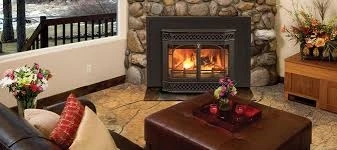Modern gas fireplace inserts are slowly replacing the traditional wood-burning fireplace. A traditional fireplace has a nice appeal thanks to the crackling wood. But it’s not fuel-efficient and takes effort to maintain and operate. In contrast, gas fireplace inserts in Denver are fuel-efficient and easy to maintain and operate.
These reasons might convince you to choose a gas firebox over a traditional wood-burning fireplace. But before you buy one, you need to think about a few things to make the most out of them.
Venting
Most fireplaces come with vents for safety and efficiency reasons. You can classify gas fireplace inserts into three categories based on venting:
Direct Venting
A direct vent system consists of an exhaust pipe that blows fumes out and an intake pipe that blows outdoor air in. It may seem counterproductive but this system helps the insert heat the room efficiently. The system uses aluminum inner walls because a gas insert’s flue is cooler than a wood-burning insert’s.
B-Venting
Also called a natural vent, releases the exhaust fumes outdoor and draws air from inside the home. It works based on the natural buoyancy of warm air. It’s popular in condos because it can be installed with a single flue system and comes at reasonable prices.
Vent-Free
Also known as ventless or unvented systems are meant for homes where setting a venting system is impossible. They pull air from indoors and emit combustion gases in the same place. They usually come with an oxygen depletion sensor (ODS) for safety and is designed to maintain air quality. But many states and cities prohibit it due to air quality concerns.
Ventilation
Fireplaces spread heat throughout the room through one of the two methods:
- Radiation: The fire transmits heat to the area nearby.
- Fan: The fan spreads the hot air efficiently throughout the room.
Fuel
An outdoor fireplace in Denver may use one of the following fuels:
Natural Gas
Natural gas is the most common fuel used by gas fireboxes in urban and suburban areas. It is a clean energy source that burns efficiently thus reducing operating costs. It’s a good option for homes with a natural gas supply.
Propane
It’s common in rural areas or homes that don’t have a natural gas supply. Propane is stored in an independent tank that supplies the insert with gas. The gas burns efficiently and produces great heat.
Ethanol
Ethanol has emerged as a popular option for standalone fireplaces. An ethanol fireplace is easy to move and install inside and outside. This type of fireplace consists of a burner and a fuel tank. Great care needs to be taken when refilling or igniting the fireplace insert.
Heating Capacity
Different insert models come with different heating capacities measured in BTUs. You need to match the unit’s capacity with the room’s size to ensure that it gets heated properly. The capacity shouldn’t be too high or too low for the room.
Safety Screen
A safety screen is important to prevent people from touching the flame or preventing it from spreading out. Fireplace glass is most commonly used as the screen to allow homeowners to enjoy the view.
Controls
It’s possible to control modern gas fireboxes with the help of remote control or wall thermostat.
Sizing
When installing an insert in an existing fireplace, you need to know how big your insert needs to be. Measure the fireplace’s height, width and depth, not including the chimney or flue. Search for inserts that can fit inside the opening. You may need fillers to ensure that the box fits perfectly.
You’ll also need to keep the local or national fire codes in mind when adding a fireplace surround.
Cost
The budget is usually the factor that decides what type of gas insert one may use. The exact cost will differ based on the insert’s model, venting system, installation charges, etc. Consider all the costs to determine your budget. Prioritize safety and quality over cost.



